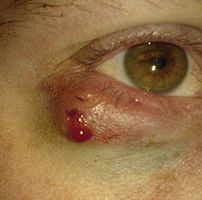[amazon_link asins=’B010QX24DQ,B00NBUQ366,B00INJ7TWW,B01M6ZKYMV,B00W8FVMNO,B01FIS2T6Q,B01I2788M4,B06XX3B2YM,B00RWG5GNQ’ template=’ProductCarousel’ store=’finmeacur-20′ marketplace=’US’ link_id=’928783e0-7721-11e7-8f1e-01ae0247b770′][amazon_link asins=’B005WJ3H7C,1543270646′ template=’ProductCarousel’ store=’finmeacur-20′ marketplace=’US’ link_id=’6b3aef58-7721-11e7-9741-b1adb6c55a59′]
This information was developed by the National Eye Institute to help patients and their families in searching for general information about anophthalmia and microphthalmia. An eye care professional who has examined the patient’s eyes and is familiar with his or her medical history is the best person to answer specific questions.
Other Names
Anophthalmos and microphthalmos, small eye syndrome.
What are anophthalmia and microphthalmia?
Anophthalmia and microphthalmia are often used interchangeably. Microphthalmia is a disorder in which one or both eyes are abnormally small, while anophthalmia is the absence of one or both eyes. These rare disorders develop during pregnancy and can be associated with other birth defects.
What causes anophthalmia and microphthalmia?
Causes of these conditions may include genetic mutations and abnormal chromosomes. Researchers also believe that environmental factors, such as exposure to X-rays, chemicals, drugs, pesticides, toxins, radiation, or viruses, increase the risk of anophthalmia and microphthalmia, but research is not conclusive. Sometimes the cause in an individual patient cannot be determined.
Can anophthalmia and microphthalmia be treated?
There is no treatment for severe anophthalmia or microphthalmia that will create a new eye or restore vision. However, some less severe forms of microphthalmia may benefit from medical or surgical treatments. In almost all cases improvements to a child’s appearance are possible. Children can be fitted for a prosthetic (artificial) eye for cosmetic purposes and to promote socket growth. A newborn with anophthalmia or microphthalmia will need to visit several eye care professionals, including those who specialize in pediatrics, vitreoretinal disease, orbital and oculoplastic surgery, ophthalmic genetics, and prosthetic devices for the eye. Each specialist can provide information and possible treatments resulting in the best care for the child and family. The specialist in prosthetic diseases for the eye will make conformers, plastic structures that help support the face and encourage the eye socket to grow. As the face develops, new conformers will need to be made. A child with anophthalmia may also need to use expanders in addition to conformers to further enlarge the eye socket. Once the face is fully developed, prosthetic eyes can be made and placed. Prosthetic eyes will not restore vision.
How do conformers and prosthetic eyes look?
A painted prosthesis that looks like a normal eye is usually fitted between ages one and two. Until then, clear conformers are used. When the conformers are in place the eye socket will look black. These conformers are not painted to look like a normal eye because they are changed too frequently. Every few weeks a child will progress to a larger size conformer until about two years of age. If a child needs to wear conformers after age two, the conformers will be painted like a regular prosthesis, giving the appearance of a normal but smaller eye. The average child will need three to four new painted prostheses before the age of 10.
How is microphthalmia managed if there is residual vision in the eye?
Children with microphthalmia may have some residual vision (limited sight). In these cases, the good eye can be patched to strengthen vision in the microphthalmic eye. A prosthesis can be made to cap the microphthalmic eye to help with cosmetic appearance, while preserving the remaining sight.
Keeping on Top of Your Condition
Keeping in tune with your disease or condition not only makes treatment less intimidating but also increases its chance of success, and has been shown to lower a patients risk of complications. As well, as an informed patient, you are better able to discuss your condition and treatment options with your physician.
A new service available to patients provides a convenient means of staying informed, and ensures that the information is both reliable and accurate. If you wish to find out more about HealthNewsflash’s innovative service, take the tour.
Resources
The following organizations may be able to provide additional information on anophthalmia and microphthalmia:
National Eye Institute
2020 Vision Place
Bethesda, MD 20892-3655
(301) 496-5248
2020@nei.nih.gov
http://www.nei.nih.gov/
American Society of Ocularists
E-mail: aso@ocularist.org
http://www.ocularist.org/
Represents technicians specializing in making and fitting of custom artificial eyes.
American Society of Ophthalmic Plastic and Reconstructive Surgery
1133 West Morse Blvd. #201
Winter Park, FL 32789
(407) 647-8839
http://www.asoprs.org
Represents ophthalmologists who specialize in reconstructive surgery involving the eye and surrounding structures. Publishes a factsheet on anophthalmos and orbital implants.
International Children’s Anophthalmia Network (ican)
Genetics, Levy 2
Albert Einstein Medical Center
5501 Old York Road
Philadelphia, PA 19141
1-800-580-4226
(215) 456-8722 or
http://www.ioi.com/ican
Provides information on anophthalmia and microphthalmia. Coordinates a patient registry. Offers referrals to local resources. Coordinates gatherings for people with anophthalmia and microphthalmia and their families. Publishes a newsletter, The Conformer.
Additional resources for parents and teachers of children with visual impairments can be found on the National Eye Institute’s website at http://www.nei.nih.gov/health/organizations.htm#resources.
For additional information, you may also wish to contact a local library.
Medical Literature
For information on your topic, you may wish to conduct a search of the medical literature. The National Library of Medicine (NLM) coordinates PubMed, a computerized medical literature database. You can conduct your own free literature search by accessing PubMed through the Internet. For help on how to search PubMed and how to get journal articles, please see PubMed Help. You may also get assistance with a literature search at a local library.
Please keep in mind that articles in the medical literature are usually written in technical language. We encourage you to share articles with a health care professional who can help you understand them.
.
Sources:http://www.nei.nih.gov/health/anoph/



















